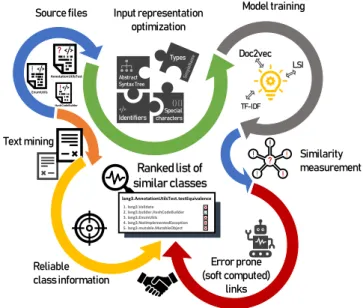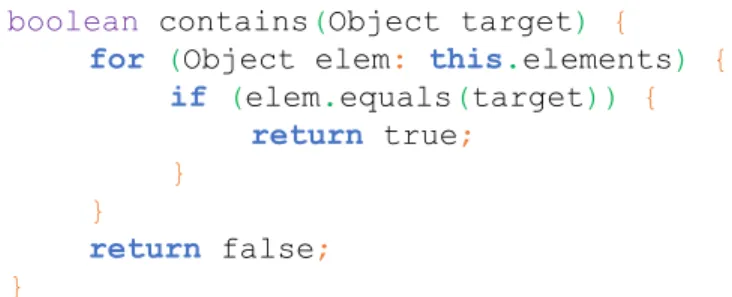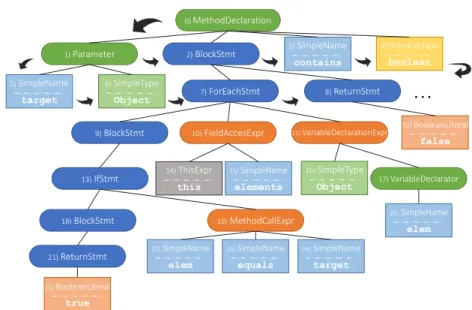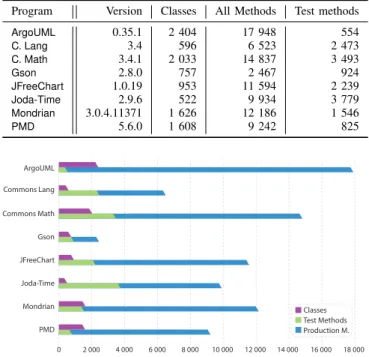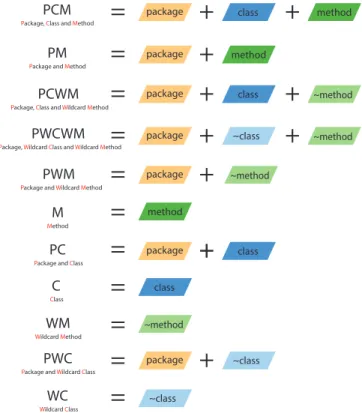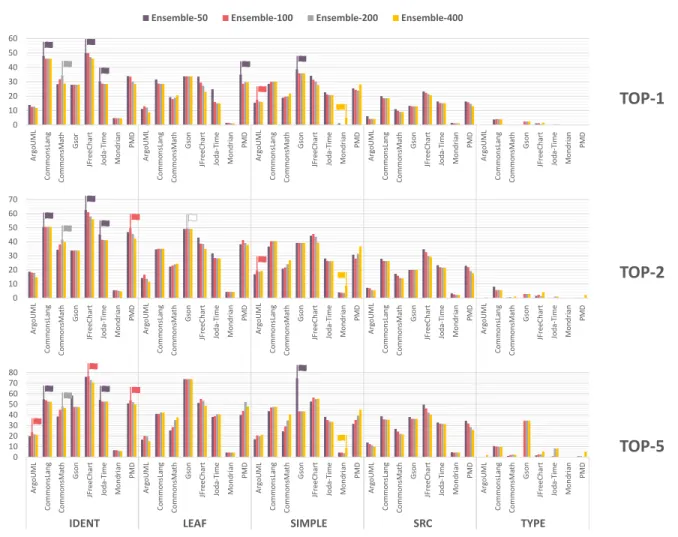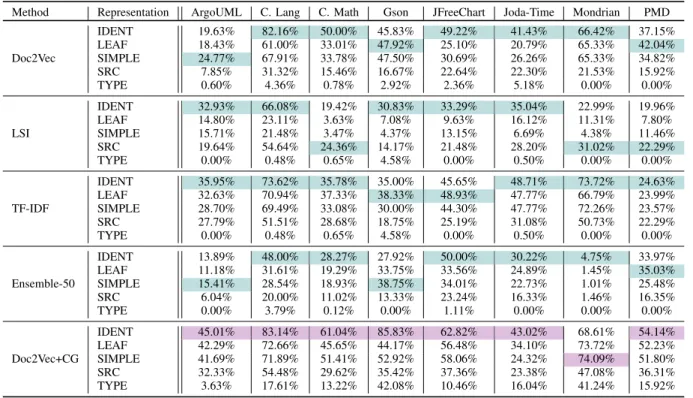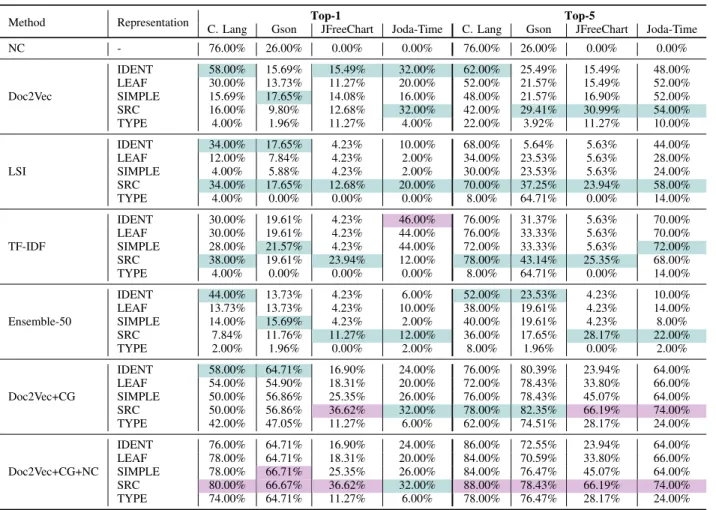Date of publication xxxx 00, 0000, date of current version xxxx 00, 0000.
Digital Object Identifier 10.1109/ACCESS.2017.DOI
Large Scale Evaluation of Natural Language Processing Based
Test-to-Code Traceability Approaches
ANDRÁS KICSI1, VIKTOR CSUVIK1, AND LÁSZLÓ VIDÁCS1
1MTA-SZTE Research Group on Artificial Intelligence, and Department of Software Engineering, University of Szeged, Szeged, Hungary
Corresponding authors: András Kicsi (e-mail: akicsi@inf.u-szeged.hu) and László Vidács (e-mail: lac@inf.u-szeged.hu).
This work was supported in part by the ÚNKP-20-3-SZTE and ÚNKP-20-5-SZTE New National Excellence Programs, by grant NKFIH-1279-2/2020N, and by the Artificial Intelligence National Laboratory Programme of the NRDI Office of the Ministry of Innovation and Technology, Hungary. László Vidács was also funded by the János Bolyai Scholarship of the Hungarian Academy of Sciences.
ABSTRACT Traceability information can be crucial for software maintenance, testing, automatic program repair, and various other software engineering tasks. Customarily, a vast amount of test code is created for systems to maintain and improve software quality. Today’s test systems may contain tens of thousands of tests. Finding the parts of code tested by each test case is usually a difficult and time- consuming task without the help of the authors of the tests or at least clear naming conventions. Recent test-to-code traceability research has employed various approaches but textual methods as standalone techniques were investigated only marginally. The naming convention approach is a well-regarded method among developers. Besides their often only voluntary use, however, one of its main weaknesses is that it can only identify one-to-one links. With the use of more versatile text-based methods, candidates could be ranked by similarity, thus producing a number of possible connections. Textual methods also have their disadvantages, even machine learning techniques can only provide semantically connected links from the text itself, these can be refined with the incorporation of structural information. In this paper, we investigate the applicability of three text-based methods both as a standalone traceability link recovery technique and regarding their combination possibilities with each other and with naming conventions.
The paper presents an extensive evaluation of these techniques using several source code representations and meta-parameter settings on eight real, medium-sized software systems with a combined size of over 1.25 million lines of code. Our results suggest that with suitable settings, text-based approaches can be used for test-to-code traceability purposes, even where naming conventions were not followed.
INDEX TERMS Software Testing, Unit Testing, Test-to-Code Traceability, Natural Language Processing, Word embedding, Latent Semantic Indexing
I. INTRODUCTION
The creation of quality software usually involves a great effort on part of developers and quality assurance specialists.
The detection of various faults is usually achieved via rigorous testing. In a larger system, even the maintenance of tests can be a rather resource-intensive endeavor. It is not exceptional for software systems to contain tens of thousands of test cases each serving a different purpose.
While their aims can be self-evident for their authors at the time of their creation, they bear no formal indicator of what they are meant to test. This can encumber the maintenance process. The problem of locating the parts of code a test
was meant to assess is commonly known as test-to-code traceability.
Proper Test-to-Code traceability would facilitate the pro- cess of software maintenance. Knowing what a test is supposed to test is obviously crucial. For each failed test case, the code has to be modified in some way, or there is little point to testing. As this has to include the identification of the production code under test, finding correct test-to- code traceability links is an everyday task, automatization would be beneficial. This could also open new doors for fault localization [1], which is already an extensive field of research, and even for automatic program repair [2], greatly
contributing to automatic fixes of the faults in the production code.
To the best of our knowledge, there is no perfect solution for recovering the correct traceability links for every single scenario. Good testing practice suggests that certain naming conventions should be upheld during the testing, and one test case should strictly assess only one element of the code. These guidelines, however, are not always followed, and even systems that normally strive to uphold them contain certain exceptions. Thus, the reliability of recovery methods that build on these habits can differ in each case.
Nonetheless, the method of considering naming conventions is one of the easiest and most precise ways to gather the correct links.
In its simplest form, maintaining naming conventions means that the name of the test case should mirror the name of the production code element it was meant to test, its name consisting of the name of the class or method under test and the word "test" for instance. The test should also share the package hierarchy of its target. In a 2009 work of Rompaey and Demeyer [3] the authors found that naming conventions applied during the development can lead to the detection of traceability links with complete precision. These, however, are rather hard to enforce and depend mainly on developer habits. Additionally, method-level conventions have various other complicating circumstances.
Other possible recovery techniques rely on structural or semantic information in the code that is not as highly de- pendent on individual working practice. One such technique is based on information retrieval (IR). This approach relies mainly on textual information extracted from the source code of the system. Based on the source code, other, not strictly textual information can also be obtained, such as Abstract Syntax Trees (AST) or other structural descriptors.
Although source code syntax is rather formal and most of the keywords of the languages are given, the code still usually contains a large amount of unregulated natural text, such as variable names and comments. There are endless possibilities in the naming of variables, functions, and classes. These names are usually quite meaningful. While source code is hard to interpret for humans as natural lan- guage text, machine learning (ML) methods commonly used in natural language processing (NLP) could still function properly.
Compared to a small manual dataset, Rompaey and Demeyer [3] found that lexical analysis (Latent Semantic Indexing - LSI) applied to this task performed with 3.7%- 13% precision while the other methods all achieved better results. Thus, it is known that IR-based methods most probably do not produce the best results in the test-to- code traceability field. However, they are in constant use in current state-of-the-art solutions. Textual methods may not be the single best way to produce valid traceability links, but modern approaches still employ them in combination with other techniques. The textual methods used in these systems are usually less current, most solutions simply rely
on matching class names or the latent semantic indexing (LSI) technique as part of their contextual coupling. Thus, finding better performing textual methods can improve these possible combinations as well, having the potential of major contributions to the field. Our findings [4] show that im- proved versions of lexical analysis can significantly outshine the previously mentioned low results, raising their average precision over 50%.
To investigate the benefits of ML models and to point out their distinction from simple naming conventions, our experiments are organized along the following research questions:
• RQ1: How generally are naming conventions applied in real systems?
• RQ2: Is there a way to further improve test-to-code traceability results relying on modern information re- trieval methods?
• RQ3:How well do various text-based techniques per- form compared to human data?
In the current paper, our goal is to recover test-to-code traceability links for tests based on only the source files. To do so, a suitable input representation is generated and from this, an artificial intelligence model is trained for the search of the most similar test-to-code match.
The paper is organized as follows. Section II presents diverse background information, including our various ap- proaches to input generation and traceability link recovery.
Our evaluation procedure and the sample projects are also described in this section. An evaluation on eight systems follows in Section III with the discussion of these results in Section IV. Related work is overviewed in Section V, some threats to validity are addressed in Section VI, while our paper concludes in Section VII.
!</>
Source files
</>
Identifiers Abstract Syntax Tree
Types
{ } [ ] Special characters
Input representation optimization
Model training
lang3.AnnotationUtilsTest.testEquivalence 1. lang3.Validate
2. lang3.builder.HashCodeBuilder 3. lang3.EnumUtils 4. lang3.NotImplementedException 5. lang3.mutable.MutableObject
Text mining
Doc2vec LSI
TF-IDF
?
! !
!
!
! Similarity
measurement
?</>
!</>
AnnotationUtilsTest
HashCodeBuilder EnumUtils
Ranked list of similar classes
Error prone (soft computed)
links Reliable
class information
FIGURE 1. A high level overview of the proposed process
II. THE PROPOSED METHOD
The goal of the current paper is to investigate textual tech- niques for the sake of improving test-to-code traceability.
This approach could improve the performance of existing techniques on this specific problem and also serve as the groundwork for future works on test-to-code traceability. To achieve this, let us grasp the process in Figure 1. The input is a software system, which consists of Java source files. The output is a ranked list for each test case with the production classes that are likely to be a target of the test. The input files are transformed in such a representation, that is more suited to machine learning than raw source code. Three techniques are trained to measure the similarity between test and code classes. Class information is also obtained from the source files like the list of imported packages and the methods defined in a class. Each model produces a list of similar code classes but these results are susceptible to faults because of the nature of ML techniques. Thus, these lists are filtered with the class information which was obtained earlier.
Our research strives to achieve a comprehensive eval- uation of three text-based techniques on the test-to-code traceability problem rather than simply providing a new method. Thus, our results were evaluated on eight real open- source programs and also using a variety of source code representations and settings. Our previous work aimed to show that LSI itself performs better than it was previously perceived by the research community [5], investigated the question of source code representations in the task, and also found that Doc2Vec can significantly outperform LSI [6]
while a suitable combination of the textual similarity tech- niques could provide even better results [4]. Some of the approaches used in the paper are also defined in our previous work but they are also briefly introduced in the following subsections.
A. LATENT SEMANTIC INDEXING
LSI is not a relatively old algorithm and there is also previous work on its uses on this specific problem. It builds a corpus from a set of documents and computes the conceptual similarity of these documents with each query presented to it. In our current experiments, the production code classes of a system were considered as the documents forming the corpus, while the test cases were considered as queries. The algorithm uses singular value decomposition to achieve lower dimension matrices which can approximate the conceptual similarity.
B. DOCUMENT VECTORS
Doc2Vec is originated from Word2vec [7], which is an artificial neural network that can transform (embed) words into vector space (embedding). The main idea is that the hidden layer of the network has fewer neurons than the input- and output layers, thus forcing the model to learn a compact representation. The novelty of Doc2Vec is that it can encode documents, not just words, into vectors containing real numbers.
C. TERM FREQUENCY-INVERSE DOCUMENT FREQUENCY
TF-IDF is a basic technique in information retrieval. It relies on numerical statistics reflecting how important a word is for a document in a corpus. The frequency value is a metric that increases each time a word appears in the document but is offset by the frequency of the word in the whole corpus, highlighting specific words for each document.
D. RESULT REFINEMENT WITHEN SEM BLEN
LEARNING
In our previous works [4]–[6] our experimental analysis led us to the conclusion that different ML techniques capture different similarity concepts. This means, that each examined technique can provide useful information, while generally, the desired code class appears close to the top of every similarity list. Thus, it should be possible to refine the obtained results a technique provides with another list that comes from a separate technique. The algorithm is very simple: only those code classes remain which are present in both similarity lists. Since every code class is ranked in the lists, we limit the search to the topNmost similar ones, this way the algorithm will drop out the classes from the first list which are not amongst the topN links of the second.
E. SOFT COMPUTED CALL INFORMATION
Since the listed techniques do not take class information into account, an additional simple filter can also be added. The following assumptions should be true in most cases: (1) the package of the class under test should either be the same as the test’s or it should be imported in the test and (2) a valid target class should have a definition for at least one method name that is called inside the body of the test case. These criteria still do not guarantee a valid match.
Methods and imports are obtained from the Java files using regular expressions. These may differ for different programming languages by their different syntax.
F. EXTENDED NAMING CONVENTION EXTRACTION The above presented techniques all result in a filtered list of soft computed links - i.e. there is no guarantee, that those are correct. Naming conventions, however, are known to produce traceability links with very high precision [3].
If a project lacks these good naming practices, naming conventions simply cannot be used in finding the correct matches. In this final approach, the naming convention is observed first. If it is applicable, it is accepted. Otherwise, the results of an IR-based approach (LSI, Doc2Vec, etc.) is considered.
Even though our experiments involved systems written in the Java programming language, the applied IR-based techniques mainly use the natural language part of the code, making the approach semi-independent from the chosen programming language. Nevertheless, language invariability cannot be guaranteed. These methods also depend on the habits of the developers. The naming conventions and the
descriptiveness of the language of the natural text factors in a great deal in textual similarity. This is why it is also crucial that the developers possess sufficient education and experience to produce sufficiently clean source code.
Furthermore, as it is visible with our current systems under test, systems with similar properties can produce vastly different results with the same methods.
Our experiments feature the extraction of program code from the systems under test using static analysis, obtaining different input representations, distinguishing tests from production code, textual preprocessing, and determining the conceptual connections between tests and production code. During our experiments, the Gensim [8] toolkit’s implementation was used for all three textual methods. The initial static analysis that provides the text of each method and class of a system in a structured manner is achieved with the Source Meter [9] static source code analysis tool.
The proposed approach recommends classes for test cases starting from the most similar and also examine the top 2 and top 5 most similar classes. Looking at the outputs in such a way makes it a recommendation system, which provides the most similar parts of production code for each test case. Examining not only the most similar class but the topN most similar ones has the benefit of highlighting the test and code relationship more thoroughly.
The proposed approach was evaluated on eight medium- sized open source projects written in Java, a further overview of these systems is available in Subsection II-I. In this paper, the models are not trained on plain source code, the feasible input representations are introduced in the next section.
boolean contains(Object target) { for (Object elem: this.elements) {
if (elem.equals(target)) { return true;
} }
return false;
}
FIGURE 2. An example method declaration, from which the AST was generated on Figure 3.
G. OPTIMAL INPUT REPRESENTATION
It is evident that the exact contents of the input are of crucial importance. In this section, we briefly describe the representations of code snippets (classes or methods) used in this work. A code representation is the input of a machine learning algorithm that computes the similarity between distinct items. Abstract Syntax Trees (AST) were utilized to form a sequence of tokens from the structured source code.
An AST is a tree that represents the syntactic structure of the source code, without including all details like punctuation
and delimiters. For instance, a sample Abstract Syntax Tree is displayed in Figure 3 which was constructed from the source code of Figure 2. To better understand the advantages and best possible methods of using the AST, the paper describes experiments on five different code representations, of which four relies on AST information. The five chosen representations are described below. The five representations under evaluation were constructed according to our previous work and are some of the most widely used representations in other research experiments [10], constructed along the work of Tufano et al. [11].
1) SRC
Let us consider the source code as a structured text file. In this simple case, similar methods are used in the context of natural language processing. These techniques include the tokenization of sentences into separate words and the application of stemming. With natural language, the sepa- ration of words can be quite simple. In the case of source code, however, we should consider other factors as well. For instance, compound words are usually written by the camel case rule, while class and method names can be separated by punctuation. The definition of these separators are one of the main design decisions in this representation. For the current work words were split by the camel case rule, by white spaces and by special characters that are specific to Java ("(", "[", "."). The Porter stemming algorithm was used for stemming. This approach notably does not use the AST of the files, making it a truly only text-based approach.
2) TYPE
To extract this representation for a code fragment, an Abstract Syntax Tree has to be constructed. This process ignores comments, blank lines, punctuation, and delimiters.
Each node of the AST represents an entity occurring in the source code. For instance, the root node of a class (Compila- tionUnit) represents the whole source file, while the leaves are the identifiers in the code. In this particular case, the types of AST nodes were used for the representation. The sequence of symbols was obtained by pre-order traversal of the AST. The extracted sequences have a limited number of symbols, providing a high-level representation.
3) IDENT
Every node in the Abstract Syntax Tree has a type and a value. The top nodes of the AST correspond to a higher level of abstraction (like statements or blocks), their values typically consist of several lines of code. The values of the leaf nodes are the keywords used in the code fragment. In this representation, these identifiers are used by traversing the AST tree and printing out the values of the leaves. The values of literals (constants) in the source code also might occur here, these are replaced with placeholders representing their type (e.g. an integer literal is replaced with the<INT>
placeholder, while a string literal with <STRING>). The
0) MethodDeclaration
2)BlockStmt
1)Parameter 4) PrimitiveType
boolean
3)SimpleName contains
6)SimpleType Object
5)SimpleName
target 7)ForEachStmt 8)ReturnStmt
9)BlockStmt 10)FieldAccesExpr 11)VariableDeclarationExpr
false
12) BooleanLiteral
14)ThisExpr this
15)SimpleName elements
13)IfStmt 16) SimpleType
Object
20)SimpleName elem
17)VariableDeclarator
19)MethodCallExpr
18)BlockStmt
true
25) BooleanLiteral
21)ReturnStmt 22)SimpleName elem
23)SimpleName equals
24)SimpleName target
. . .
FIGURE 3. An Abstract Syntax Tree, generated from the example of Figure 2. The numbers inside each element indicate the place of the node in the visiting order.
Leaves are denoted with standard rectangles (note that here the value and the type is also represented), while intermediate nodes are represented by rectangles with rounded corners.
extracted identifiers contain variable names. In the current experiments, they were split according to the camel case rule popularly used in Java.
4) LEAF
In the previous two representations, distinct parts of the AST were utilized to get the input. This approach takes both the types and node values into account. Just as before, a pre-order visit is performed from the root. If the node is an inner node then its type, otherwise (when it is a leaf) its value is printed. This representation captures both the abstract structure of the AST and the code-specific identifiers. Considering the latter, these can be very unique and thus very specific to a class or a method.
5) SIMPLE
The extraction process is very similar to the previous one, except that in this case only values with a node type of SimpleName are printed out. These nodes occur very often, they constituted 46% of an AST on average in our experiments. These values correspond to the names of the variables used in the source code while other leaf node types like literal expressions or primitive types hold very specific information. Note that in the IDENT representation, the replacing of literals eliminated the AST node types of literal expressions. Only the modifiers, names, and types remained, thus becoming similar to this representation. With this representation, however, we do not exclude the inner structure of the AST.
H. EVALUATION PROCEDURE
In their 2009 evaluation, Van Rompaey B. and Demeyer S.
[3] found that the naming conventions technique produced 100% precision in finding the tested class at each test case
it was applicable to. The authors used a human test oracle consisting of 59 randomly chosen test cases altogether.
These can be considered too few measuring points for proper generalization, but nevertheless, it is visible that naming conventions can identify the class under test in the overwhelming majority of the cases. Naming convention pairs can also be extracted automatically from method, class, and package names. Thus, one of our evaluation methods relies on the naming conventions technique.
Since naming convention habits may influence this, our approach was also evaluated on a human test oracle de- scribed in [12]. TestRoutes is a manually curated dataset that contains data on four of our eight subject systems, Commons Lang, Gson, JFreeChart and Joda-Time. It is a method-level dataset that classifies the traceability links of 220 test cases (70 from JFreeChart, 50 from each of the others). This information is also suitable for class-level evaluations, as this is a relaxed version of the same problem. The dataset lists the methods under test as focal methods (there can be multiple focal methods for a test case), as well as test and production context. Our current focus is on the classes of these focal methods. For JFreeCart and Joda-Time, the dataset specifically targeted test cases that were not covered with simple naming conventions, this will also be evident at our results. For the other systems, the dataset contains data on randomly chosen test cases.
The TestRoutes data was annotated by a graduate student familiar with software testing. The tests were not executed during the annotation process. The annotator worked in an integrated development environment, studied the systems’
structure beforehand, and maintained regular communica- tion with the researchers, addressing the arising concerns.
The collected traceability links were inspected and validated by a researcher, with another researcher also verifying the
links of at least ten test cases of each system.
A relatively simple yet sufficiently strict set of rules was applied in the naming convention based evaluation. Our NC-based evaluations were based on package hierarchy and exact name matching. This is further detailed in Subsec- tion III-A, where this particular naming convention ruleset is referred to as PC (package + class).
The well-known precision metric was utilized to quantify our results. Precision is the proportion between correctly detected units under test (UUT) and all detected units under test. It computes as
precision= relevantU U T ∩retrievedU U T retrievedU U T
With such an evaluation, it is only possible to find one pair to each test case correctly. Our methods produce a list of rec- ommendations in order of similarity. Every class is featured on this list. Thus, with our current evaluation methods, the customary precision and recall measures always coincide, which necessarily means that the F-measure metric would also have the same value. This is in accordance with the evaluation techniques commonly used for recommendation systems in software engineering. Because of this equality, we shall refer to our quantified results in the future as precision only.
I. SAMPLE PROJECTS
Our results were evaluated on multiple software systems and with multiple settings. These involved the following open- source systems: ArgoUML is a tool for creating and editing UML diagrams. It offers a graphic interface and relatively easy usage. Commons Lang is a module of the Apache Commons project. It aims to broaden the functionality provided by Java regarding the manipulation of Java classes.
Commons Math is also a module of Apache Commons, aiming to provide mathematical and statistical functions missing from the Java language. Gson is a Java library that does conversions between Java objects and Json format effi- ciently and comfortably. JFreeChart enables Java programs to display various diagrams, supporting several diagram types and output formats. Joda-Time simplifies the use of date and time features of Java programs. The Mondrian Online Analytical Processing (OLAP) server improves the handling of large applications’ SQL databases. PMD is a tool for program code analysis. It explores frequent coding mistakes and supports multiple programming languages.
The versions of the systems under evaluation, their total number of classes and methods, and the number of their test methods are shown in Table 1, while Figure 4 visually re- flects these numbers. It has to be noted that several methods of the test packages of the projects have been filtered out as helpers since they did not contain any assertions.
TABLE 1. Size and versions of the programs used
Program Version Classes All Methods Test methods
ArgoUML 0.35.1 2 404 17 948 554
C. Lang 3.4 596 6 523 2 473
C. Math 3.4.1 2 033 14 837 3 493
Gson 2.8.0 757 2 467 924
JFreeChart 1.0.19 953 11 594 2 239
Joda-Time 2.9.6 522 9 934 3 779
Mondrian 3.0.4.11371 1 626 12 186 1 546
PMD 5.6.0 1 608 9 242 825
0 ArgoUML Commons Lang Commons Math Gson JFreeChart Joda-Time Mondrian
PMD
2 000 4 000 6 000 8 000 10 000 12 000 14 000 16 000 18 000 Classes Test Methods Production M.
FIGURE 4. Properties of the sample projects used
III. RESULTS
The current section evaluates the various approaches de- scribed in the previous section, featuring the results obtained from different representations and learning settings. First, various naming convention possibilities are overviewed with their applicability values determined via automatic extrac- tion. Next, our experiments with the ensembleN approach are presented, where the best N value has been sought on NC-based and manual traceability links. Finally, the traceability approaches are compared to each other based on both NC and manual evaluation.
We note that production methods containing less than three tokens in their method bodies were filtered out since trivial and abstract production methods are not likely to be the real focus of a test.
A. APPLICABILITY OF NAMING CONVENTIONS
Naming conventions for tests are a vague term that can mean a multitude of various practices. The conventions are usually agreed on by the developers and written guidelines rarely even exist. They can also be only considered a mere good practice, and their use varies by teams or even individuals.
As there can be various naming conventions, and their use is different in most systems, relatively vague criteria are needed to detect them in a versatile manner. Let us con- sider a few general criteria for our examination. These are presented in Figure 5. There are, of course, other possible criteria, including abbreviations or some other distinction for tests except the word "Test". Still, these seem to be the most intuitive and most popular naming considerations.
Let us consider some of the possible combinations of the listed criteria components. Figure 6 presents these. Some
other viable combinations can also exist, which did not seem suitable for the unique distinction of test-code pairs. The criteria are ordered by strictness in a descending manner.
While the stricter criteria produce more distinction between pairs, they are less versatile and are harder to uphold. Table 2 presents the extent to which the naming conventions were found to be applicable to the evaluated systems.
class
package The package hierarchy must match either completely or after the "test" or "tests" package.
a.b.c.SomeClass test.a.b.c.TestSomeClass a.b.c.SomeClass a.b.TestSomeClass The name of the test class must
match completely with the production class, the word "Test"
appended to the beginning or the end.
The name of the class must contain the whole name of the production class.
The name of the test method must match completely with the production method, except for the word "Test" appended to the beginning or the end.
The name of the method must contain the whole name of the production method.
SomeClass SomeClassTest SomeClass AnotherSomeClassTest SomeClass OtherTest
someMethod someMethod someMethod
someMethodTest anotherSomeMethodTest otherTest
someMethod someMethod someMethod
someMethodTest anotherSomeMethodTest otherTest
SomeClass SomeClassTest SomeClass AnotherSomeClassTest SomeClass OtherTest
~class
method
~method
FIGURE 5. Various possible naming convention criteria components
PCM
Package, Class and Method
PM
Package and Method
M
Method
WM
Wildcard Method
PWM
Package and Wildcard Method
PCWM
Package, Class and Wildcard Method
PWCWM
Package, Wildcard Class and Wildcard Method
= +
=
package package package package package
=
~class=
=
=
=
methodmethod
+
classclass
+
+
~method~method
+
~class
+
package
PC
Package and Class
PWC
Package and Wildcard Class
WC
Wildcard Class
C
Class
package
=
=
=
=
+
class
class
~class
~class
+
package
+
method+
~method~method
+
FIGURE 6. Some of the possible naming convention criteria in descending order of restrictiveness
As it is visible from the results of the table, there is a significant jump in the applicability at the PC naming
convention variant, which considers package hierarchy and an exact match to the name of the class. While the extent of the increase of applicability varies between systems, it is apparent that most of them produce only very few traceability links when method names are also considered.
As our experiments at the current time feature class level test-to-code traceability, the further results of our paper will use PC as the default naming convention.
B. ENSEMBLE EXPERIMENTS
Figure 7 and Figure 8 show the results of our ensembleN
learning approach. As one can see in the figures, the experiments were carried out using different N values: 50, 100, 200, and 400. These values only influence the size of each similarity list. IfNis relatively big, then the filtering on the original similarity list (which originates from Doc2Vec) will not drop out many entries since many of the elements are present in the other two lists. In contrast, ifNis a small number, the filtering is stricter since every similarity list contains only a limited number of entries. The previous argument can be further elaborated: ifNisbig, the resulting similarity list is going to rely mostly on the original one, while if it is small, the approach makes better use of the information from the other two approaches.
First, let us consider Figure 8, which visualizes the results from the sample projects measured via automatic naming convention extraction. The small flags on the top of the bars indicate the highest values for each system in their category (top1,top2,top5). The flag’s color is the same as its bar; a white flag means that the highest values are equal.
Remarkably, no case was encountered where there were two or three highest values. In this experiment, the different source code representations are also considered. Looking at the figure, it is apparent that most of the flags appear at the IDENT representation. It is also worth mentioning that at thetop1results, theensemble50approach seems to produce the highest values. Considering multiple recommendations (top2andtop5), the situation is less obvious:ensemble100
also seems to provide good results.Ensemble400 seems to be less precise. It prevalent only in the case of Mondrian using the SIMPLE representation. The results on the manual dataset also reinforce this finding. In Figure 7, almost every flag belongs to the ensemble50 approach, except in two cases, when it produced the same value as the others.
C. NC-BASED EVALUATION
Table 3 shows thetop1results of different machine learning approaches, evaluated via naming conventions. Cells of color teal indicate the highest values for each system within a method, while cells of color violet indicate the overall top values. For theEnsembleN, only those cases are listed where N = 50, since this setting seemed to be the most beneficial (for further discussion see Subsection III-B). The listed approaches correspond to the ones introduced in Sec-
TABLE 2. The applicability of the naming conventions technique using different approaches
Naming Criteria ArgoUML Commons Lang Commons Math Gson JFreeChart Joda-Time Mondrian PMD
PCM 14.91% 17.04% 12.50% 1.74% 32.60% 3.60% 6.57% 7.93%
PM 20.73% 19.80% 16.85% 2.18% 38.95% 10.09% 9.04% 8.43%
PCWM 19.82% 56.67% 32.19% 9.59% 49.53% 23.78% 11.51% 15.86%
PWCWM 21.27% 66.73% 37.52% 9.59% 50.92% 59.65% 12.09% 16.48%
PWM 33.45% 70.79% 45.42% 15.47% 58.64% 74.42% 31.01% 25.53%
M 28.91% 19.96% 21.16% 3.05% 40.15% 11.38% 12.22% 11.90%
PC 60.18% 84.58% 75.07% 26.14% 96.47% 36.80% 17.82% 58.36%
C 64.00% 84.58% 75.07% 27.89% 96.47% 37.30% 20.81% 66.91%
WM 74.00% 80.00% 81.53% 60.24% 61.28% 78.55% 73.34% 58.36%
PWC 75.09% 99.11% 88.06% 28.87% 97.05% 98.04% 21.52% 61.09%
WC 80.55% 99.11% 91.42% 44.77% 97.41% 98.04% 35.96% 72.12%
0 10 20 30 40 50 60 70
CommonsLang Gson JFreeChart Joda-Time CommonsLang Gson JFreeChart Joda-Time CommonsLang Gson JFreeChart Joda-Time CommonsLang Gson JFreeChart Joda-Time CommonsLang Gson JFreeChart Joda-Time
IDENT LEAF SIMPLE SRC TYPE
TOP-5
IDENT LEAF SIMPLE SRC TYPE
0 10 20 30 40 50 60
CommonsLang… Gson JFreeChart Joda-Time CommonsLang… Gson JFreeChart Joda-Time CommonsLang… Gson JFreeChart Joda-Time CommonsLang… Gson JFreeChart Joda-Time CommonsLang… Gson JFreeChart Joda-Time 0
105 15 20 2530 35 40 4550
CommonsLang… Gson JFreeChart Joda-Time CommonsLang… Gson JFreeChart Joda-Time CommonsLang… Gson JFreeChart Joda-Time CommonsLang… Gson JFreeChart Joda-Time CommonsLang… Gson JFreeChart Joda-Time Ensemble-50 Ensemble-100 Ensemble-200 Ensemble-400
TOP-2TOP-1
FIGURE 7. Results of theensembleNlearning approach measured on the manual dataset.
tion II. The notion [approach]+CG refers to filtering with our soft computed call information described in Section II-E.
D. EVALUATION ON MANUAL DATA
The results measured on the manual dataset are shown in Table 4. Similarly to the previous table, teal indicates the highest values within a method, while violet highlights the overall highest value. The left part of the table shows
precision values of top-1 matches, while on the right side of the table, the top-5 results are listed. The top-5 results are always equal or higher than the top-1 numbers since there are more than one similar matches considered during the evaluation. Here, the results of different approaches are compared to the dataset’s data, which contains manually curated traceability links on four of our subject systems.
In this table, two additional rows are introduced. The first row shows the applicability of the naming convention (that was denoted PC in the previous subsection). These numbers depict the conventions’ applicability to the specific test cases in the dataset, rather than the whole system. If naming conventions should be considered accurate, this value would intuitively correspond to the precision that could be achieved without any additional IR-based approach, only relying on the names. The last line’s title contains theNCaddition. Our method here first attempts to detect the link using naming conventions, and if it fails, the suggestion of Doc2Vec is considered. If the resulting precision values would be lower than before, that would either mean that the dataset is incorrect, or the naming conventions were misleading. It is also clear that if the results of this approach and the plain NC approach were equal, then the IR-based addition would be unnecessary. Eventually, none of these concerns were found to be reflected in Table 4. In fact, this approach produced the best results in almost every single case.
IV. DISCUSSION
A. NAMING CONVENTIONS HABITS
The previous section displayed some of the most common naming convention techniques and some data on how fre- quently they seem to have been utilized in the systems currently under our investigation.
Let us consider an example of how a perfect match would look like viewing all three of package hierarchy, class name, and method name. One such example for Commons Math is illustrated in Figure 9, which shows a test case (T) and the production method it is meant to test (P). If every single test case related to its method under test with such simplicity, test-to-code traceability would be a trivial task.
Unfortunately, as it is visible from our applicability results,
0 10 20 30 40 50 60
ArgoUML… CommonsLang CommonsMath Gson JFreeChart Joda-Time Mondrian PMD ArgoUML… CommonsLang CommonsMath Gson JFreeChart Joda-Time Mondrian PMD ArgoUML… CommonsLang CommonsMath Gson JFreeChart Joda-Time Mondrian PMD ArgoUML… CommonsLang CommonsMath Gson JFreeChart Joda-Time Mondrian PMD ArgoUML… CommonsLang CommonsMath Gson JFreeChart Joda-Time Mondrian PMD Ensemble-50 Ensemble-100 Ensemble-200 Ensemble-400
0 10 20 30 40 50 60 70
ArgoUML… CommonsLang CommonsMath Gson JFreeChart Joda-Time Mondrian PMD ArgoUML… CommonsLang CommonsMath Gson JFreeChart Joda-Time Mondrian PMD ArgoUML… CommonsLang CommonsMath Gson JFreeChart Joda-Time Mondrian PMD ArgoUML… CommonsLang CommonsMath Gson JFreeChart Joda-Time Mondrian PMD ArgoUML… CommonsLang CommonsMath Gson JFreeChart Joda-Time Mondrian PMD
0 10 20 30 40 50 60 70 80
ArgoUML CommonsLang CommonsMath Gson JFreeChart Joda-Time Mondrian PMD ArgoUML CommonsLang CommonsMath Gson JFreeChart Joda-Time Mondrian PMD ArgoUML CommonsLang CommonsMath Gson JFreeChart Joda-Time Mondrian PMD ArgoUML CommonsLang CommonsMath Gson JFreeChart Joda-Time Mondrian PMD ArgoUML CommonsLang CommonsMath Gson JFreeChart Joda-Time Mondrian PMD
IDENT LEAF SIMPLE SRC TYPE
IDENT LEAF SIMPLE SRC TYPE
TOP-1
TOP-2
TOP-5
FIGURE 8. Results of theensembleNlearning approach using NC-based evaluation.
this is very far from reality.
org.apache.commons.math4.ode.events.EventFilterTest.eventOccurred
package hierarchy class method org.apache.commons.math4.ode.events.EventFilter.eventOccurred
T P
FIGURE 9. A trivial naming convention example from Commons Math
According to our results, the names of test methods are much less likely to mirror the names of their production pairs correctly. Although our experiments only deal with eight open-source systems, it is highly probable that the developers of other systems also tend to behave similarly in focusing more on class-level naming conventions. WM (wildcard method) is obviously full of noise and accidental matches and cannot be considered seriously. PM (pack- age+method) is a much more precise option but as it is
visible it was found to be used in about every fifth case. One obvious reason for this can be that it is significantly harder to convey all the necessary information in method names.
Production method names should be descriptive and lead to an easy to understand and quick comprehension of what the method does. This is also true about the names of test cases, they should also refer to what functionality they are aiming to assess. Consequently, the names of the test cases would become rather long if they always aimed to contain both the name of the method or methods under test and also provide additional meaningful information about the test itself. It can also be tough to properly reference the method under test on method level by naming conventions only.
Polymorphism enables the creation of several methods with identical names that perform similar functionalities with different parameters. These should be tested individually, and test names can have a hard time distinguishing these.
The inclusion of parameter types can be a possible solution as performed in Commons Lang for example, at the test case test_toBooleanObject_String_String_String_String, testing the production methodtoBooleanObjectthat gets four String parameters. Our manual investigation shows that test meth-
TABLE 3. Top-1 results featuring the different text-based models trained on various source code representations, evaluated using naming conventions. - highest value in a row - highest value in a column
Method Representation ArgoUML C. Lang C. Math Gson JFreeChart Joda-Time Mondrian PMD
IDENT 19.63% 82.16% 50.00% 45.83% 49.22% 41.43% 66.42% 37.15%
LEAF 18.43% 61.00% 33.01% 47.92% 25.10% 20.79% 65.33% 42.04%
Doc2Vec SIMPLE 24.77% 67.91% 33.78% 47.50% 30.69% 26.26% 65.33% 34.82%
SRC 7.85% 31.32% 15.46% 16.67% 22.64% 22.30% 21.53% 15.92%
TYPE 0.60% 4.36% 0.78% 2.92% 2.36% 5.18% 0.00% 0.00%
IDENT 32.93% 66.08% 19.42% 30.83% 33.29% 35.04% 22.99% 19.96%
LEAF 14.80% 23.11% 3.63% 7.08% 9.63% 16.12% 11.31% 7.80%
LSI SIMPLE 15.71% 21.48% 3.47% 4.37% 13.15% 6.69% 4.38% 11.46%
SRC 19.64% 54.64% 24.36% 14.17% 21.48% 28.20% 31.02% 22.29%
TYPE 0.00% 0.48% 0.65% 4.58% 0.00% 0.50% 0.00% 0.00%
IDENT 35.95% 73.62% 35.78% 35.00% 45.65% 48.71% 73.72% 24.63%
LEAF 32.63% 70.94% 37.33% 38.33% 48.93% 47.77% 66.79% 23.99%
TF-IDF SIMPLE 28.70% 69.49% 33.08% 30.00% 44.30% 47.77% 72.26% 23.57%
SRC 27.79% 51.51% 28.68% 18.75% 25.19% 31.08% 50.73% 22.29%
TYPE 0.00% 0.48% 0.65% 4.58% 0.00% 0.50% 0.00% 0.00%
IDENT 13.89% 48.00% 28.27% 27.92% 50.00% 30.22% 4.75% 33.97%
LEAF 11.18% 31.61% 19.29% 33.75% 33.56% 24.89% 1.45% 35.03%
Ensemble-50 SIMPLE 15.41% 28.54% 18.93% 38.75% 34.01% 22.73% 1.01% 25.48%
SRC 6.04% 20.00% 11.02% 13.33% 23.24% 16.33% 1.46% 16.35%
TYPE 0.00% 3.79% 0.12% 0.00% 1.11% 0.00% 0.00% 0.00%
IDENT 45.01% 83.14% 61.04% 85.83% 62.82% 43.02% 68.61% 54.14%
LEAF 42.29% 72.66% 45.65% 44.17% 56.48% 34.10% 73.72% 52.23%
Doc2Vec+CG SIMPLE 41.69% 71.89% 51.41% 52.92% 58.06% 24.32% 74.09% 51.80%
SRC 32.33% 54.48% 29.62% 35.42% 37.36% 23.38% 47.08% 36.31%
TYPE 3.63% 17.61% 13.22% 42.08% 10.46% 16.04% 41.24% 15.92%
ods are indeed more likely to be named after the functional- ity they mean to test rather than after single methods even if they only test one method. One method can also be tested by multiple test cases. Thus this is not a very surprising circumstance. It is apparent that naming conventions on the method level have to be more complicated, and their maintenance necessitates more work on the part of the developers. Thus, method-level naming solutions are likely to be a less valuable option in method-level test-to-code traceability. On the other hand, method-level traceability still requires proper class-level traceability. Thus, names should still be helpful.
Talking about classes, production class names seem to be mirrored more often in their test classes’ names. This, however, still can be a highly unsteady habit depending on the system. While in Mondrian, production class names are only present in test names once in every fifth case, the same applies to 2160 of the 2239 test cases of JFreeChart.
Thus, not surprisingly, it is evident that naming conventions depend on developer habits. The remaining test cases of JFreeChart were also examined, these are overwhelmingly cases where a specific type of charts or other higher-level functionalities are tested, and the test classes are named after these. These cases often depend on multiple production classes providing lower-level functionality.
Mirroring the package-hierarchy of the production code while composing tests is also a good practice. The little difference between the C (class) and PC (package+class) values in Table 2 shows that developers are very likely
to uphold this. This convention is likely to be even more popular than naming matches. Package hierarchy matches are easier to maintain than names and are more convenient as they do not really require additional work from the developers. Even if multiple methods or classes are under tests, their packages only rarely differ. It could also be seen as another level of abstraction. Package hierarchy can only provide very vague clues about traceability links but can be suitable for the elimination of some of the false matches or at least presenting a warning sign about some matches.
From the difference of matches found with C-PC and WC- PWC (wildcard class - packate + wildcard class), our manual investigation provided less conclusive results.
On the one hand, many systems contain some seemingly arbitrary exceptions to this rule that were most probably due to some design decision or modification in the production code that the structure of the tests has not followed yet.
Gson, for example, has a "gson" package in its test structure that contains similarly named test classes to the "internal"
package of the production code. Another example can be given from PMD, where there is an extra "lang" package in the hierarchy of the production code, that is not found at the test structure, even though all prior packages match.
These are far from system-wide decisions as seen from the NC applicability percentages, but can be hard to detect by automatic means. On the other hand, some faulty matches do exist when not considering the package hierarchy. This can be seen at ArgoUML for instance, the "Setting" class of the production code can match with a lot of test classes if
